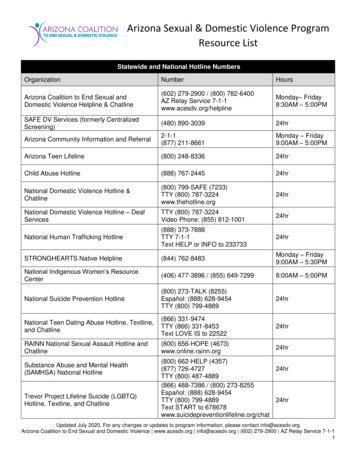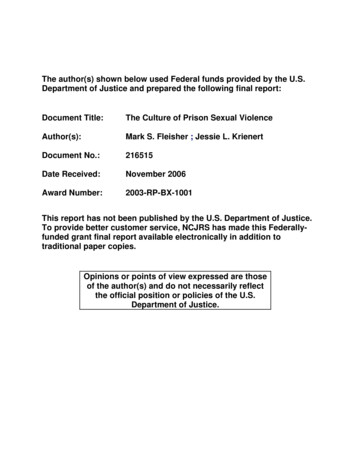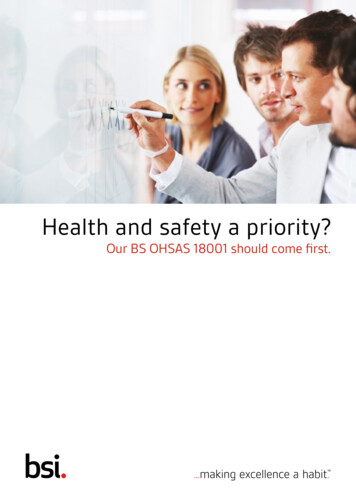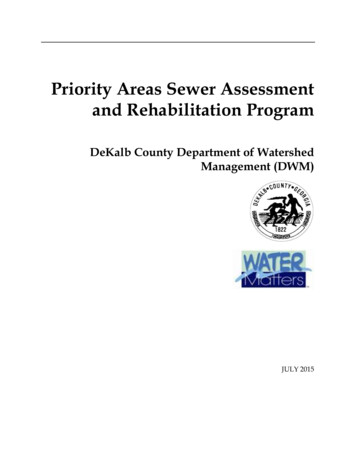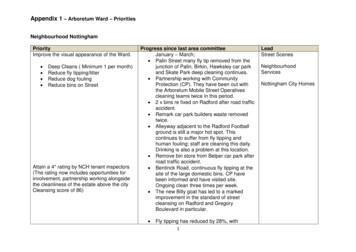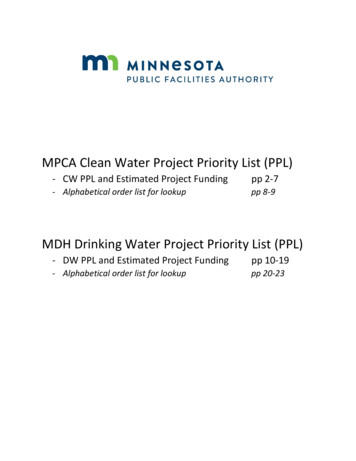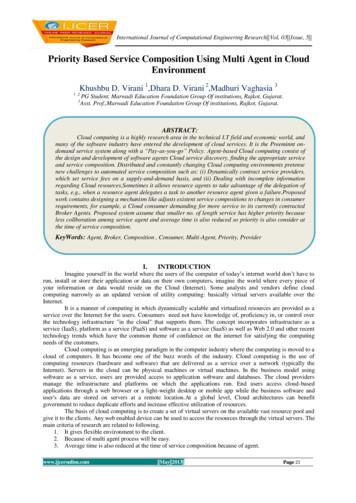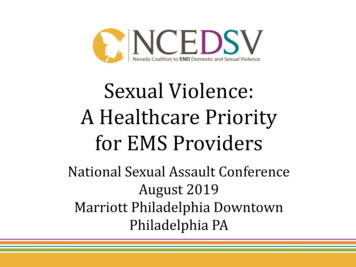
Transcription
Sexual Violence:A Healthcare Priorityfor EMS ProvidersNational Sexual Assault ConferenceAugust 2019Marriott Philadelphia DowntownPhiladelphia PA
Acknowledgements This presentation was supported by Grant No.2018-MU-AX-0015 awarded by the Office onViolence against Women, U.S. Department ofJustice. The opinions, findings, conclusions, andrecommendations expressed in thepresentation are those of the author(s) and donot necessarily reflect the views of theDepartment of Justice, Office on ViolenceAgainst Women.
Presentation compiled by:Judy Henderson, MEd. Mgt.Training CoordinatorNevada Coalition to End Domestic and Sexual Violence775.828.1115 ext. 44judyh@ncedsv.org; www.ncedsv.orgNCEDSV Online Healthcare Toolkitwww.ncedsv.org/resources/healthcare-toolkit
A Call to ActionIt is critical that health careproviders understand how torespond to victims of intimatepartner violence includingsexual assault by conductinghealth and safety assessments,interventions, documentation,and referrals.Futures Without Violence4
Intimate partner violence is the “only category ofcrime in which the perpetrator frequently remainson the scene, expecting no negative consequencesand actually perceiving intervention as a violation oftheir rights.” EMS Response to Domestic Violence5
Rationale for Healthcare Intervention American College of Emergency PhysiciansPolicy states “that training in the evaluation andmanagement of victims of IPV should beincorporated into the initial and continuingeducation of EMS personnel. This training shouldinclude the recognition of victims and injuries, anunderstanding of the patterns of abuse and how thisaffects care, scene safety, preservation of evidenceand documentation requirements.”6
“Several months ago, I was told by a rape crisiscounselor that, “A lot of rape cases are lost because ofEMTs.” EMS providers work well at addressing thepatient’s medical needs, but often fail to comprehendor meet a patient’s emotional needs, causing awithdrawal of cooperation from within judicialprocess. EMS education also leaves large gaps inknowledge needed to help preserve biologicalevidence and maintain the chain of custody ofevidence taken into our possession. EMS providersplay an important role whether or not an immediatelife threat is present.”Provide Emotional First Aid When Responding toSexually Assaulted Patients, JEMS, 2015
Role of EMTs and Paramedics Patient may be more candid withyou than with law enforcement You may be the only witness tothe home environment Assess and document injuries:Identification of IPV can be thefirst step in interrupting theprogression of violence You can empower the survivor/your patient withsupport to promote healing, reassure privacy &confidentiality, educational information, andcommunity-based resources8
Presentation Objectives
Objectives1. Determine the scope of the problem as it relates to EMShealthcare response;2. Define intimate partner violence (IPV) including sexualassault;3. Identify the common medical conditions associated with IPVincluding sexual assault; and4. Discuss the guiding principles for an improved EMS responsethrough a trauma-informed lens. This includes safety for thefirst responders, routine screening, intervention,documentation, and making appropriate referrals tocommunity-based sexual assault advocacy services; and5. Scenarios will be used to increase participant’s understandingof these key principles followed by a discussion of first stepsin developing a successful partnership with first responders.10
TerminologyIPV & SA Definitions
A Working Definition forIntimate Partner Violence (IPV)IPV is a PATTERN of assaultive and coercive behaviors that mayinclude:– Inflicted physical injury– Psychological/Emotional abuse– Sexual assault– Economic coercion– Progressive social isolation– Stalking– Deprivation of medical care & medications– No access to or destruction of assistive devices– Intimidation/ThreatsThese behaviors can be committed by an adult or adolescent with thegoal to establish or maintain POWER and CONTROL by one partnerover the other.12
Defining Sexual Violence A sexual act that is committed or attempted byanother person WITHOUT FREELY GIVEN CONSENTof the victim or against someone who is unable toconsent or refuse.– Forced or alcohol/drug facilitated penetration of avictim; forced or alcohol/drug facilitated incidents inwhich the victim was made to penetrate a perpetrator orsomeone else;– Non-physically pressured unwanted penetration;– Intentional sexual touching; or– Non-contact acts of a sexual nature.Source: Centers for Disease Control & Prevention 2014
Sexual Violence Sexual violence can also occur when a perpetrator forces orcoerces a victim to engage in sexual acts with a third party. Sexual violence involves a lack of freely given consent as well assituations in which the victim is unable to consent or refuse:– Consent Words or overt actions by a person who is legally or functionallycompetent to give informed approval, indicating a freely given agreementto have sexual intercourse or sexual contact.– Inability to Consent A freely given agreement to have sexual intercourseor sexual contact could not occur because of the victim’s age, illness,mental or physical disability, being asleep or unconscious, or being toointoxicated (e.g., incapacitation, lack of consciousness, or lack ofawareness) through their voluntary or involuntary use of alcohol ordrugs.– Inability to Refuse Disagreement to engage in a sexual act was precludedbecause of the use or possession of guns or other non-bodily weapons, ordue to physical violence, threats of physical violence, intimidation orpressure, or misuse of authority.
Scope of the Problem
Statistics in the U.S. One out of three women have experienced physical violenceby an intimate partner at some point in their lives. Nearly80% of women report verbal abuse. CDC 2010 It’s estimated that 1 in 5 college women and 1 in 16 collegemen will be sexually assaulted before graduation. Krebs CP etal, The campus sexual assault study. National Criminal Justice Reference Service2007 Approx. 1 in 5 women have been raped in their lifetimes &almost 50% of American women have experienced sexualassault other than rape. CDC 2010 For every 100 sexual assaults, there are only 32 that lead topolice reports. Of these reports there are only two felonyconvictions with as few as two rapists spending just asingle day in prison. RAINN Reporting Rates 200916
Statistics - Native Americans Native American women sufferIPV at 50% higher rates thanother ethnicities. DOJ 2004 55% of women and 43.2% ofmen reported experiencingphysical violence by anintimate partner.NIJ May 2016; CDC 2010 86% of Native Americanwomen who report sexualviolence say they wereattacked by a non-Native man.Source: National Task Forceto End Domestic Violence17
Statistics – Pregnancy 40% of pregnant women whohave been exposed to abuse reportthat their pregnancy wasunintended, compared to just 8%of non-abused women.Hathaway et al 2000 Approximately 1 in 5 youngwomen said they experiencedpregnancy coercion & 1 in 7experienced active interferencewith contraception (birth controlsabotage.)National Crime Victim Survey 200518
Dynamics of theIPV Relationship
DemographicsAnyone can be a perpetrator or victim of IPV.They come from all groups, regardless of: Race/Ethnicity Culture Class Education Occupation Age Physical Ability Gender Identity Sexual Orientation (LGBTQ ) Personality Traits20
“Power and Control Wheel”
This wheel isgender-neutral &was adaptedfrom theDomestic AbuseInterventionProject Duluth,Minnesota.22
Sexual Violence Makes demeaning remarks about intimate body parts Looks or touches the partner sexually in ways thatmake them feel uncomfortable Bruises around breasts or genital area, vaginal/analbleeding, torn or bloody underwear Takes advantage of physical/mental illness ordisability to engage in sex Sexual contact that is forced (rape/sodomy) Sexual assault/violent actions meant to humiliate,terrorize, and degrade the victim24
Sexual Violence Coerced nudity; exhibitionism (masturbation,indecent exposure) Forces partner to watch pornography on TV and/orthe computer – taking photos of sexual acts that areexplicit & exploitative Not using protection from STIs Using spiritual practices such as doctoring & sweatlodges to take advantage of closed surroundings tocommit sexual acts. Uses their status as spiritualadvisors or traditional healer to engage in sex to“heal” the woman or they will use “bad” medicine25against them
Barriers for IPV Victims:Addressing the MostCommon Question,“Why don’t they justleave?”
Why Doesn’t My Patient Just Leave?“My doctor asked me why Ijust didn’t leave in a veryirritated, demeaning way. Helooked at me like I was stupid.It never occurred to him that Ihad left, but that my husbandjust tracked me down again.He doesn’t know my husbandkeeps threatening to kill thekids and me if I leave. I amafraid and I am scared.”27
Barriers to Leaving for IPV VictimsHistory of having received inappropriate and victimblaming responses from family & friends, faithleaders, healthcare providers, law enforcement,counselors “Why don’t you just leave?” “You are stupid forstaying with him.” “What did you do to deserve this?” “You’ve made your own bed now lie in it.” “You need to pray about becoming a better wife.”“Your role as a wife is to serve your husband andyour family.” “Never deny your husband.”28
Barriers to Leaving Without intervention, violent episodes tend to recur andescalate in intensity Typically, victims may leave 7-8 times before they perceivethey are safe enough and establish resources to make thebreak DISABILITY: fear of losing health insurance, fear ofinstitutionalization, physically restrained when denied accessto wheelchair, no access to doctor, caregiver, and/ormedication. If the victim has a disability, it may take on theaverage 12 times before they feel safe enough and establishresourcesThe most dangerous time for a victim,is when they decide to leave the relationship!29
Common Medical Conditions &Injuries Associated with IPVincluding Sexual Assault
More than broken bones andblack eyes(Centers for Disease Control and Prevention)
Common Medical Conditions Chronic back, chest, and abdominal pain Frequent, painful headaches – migraines Frequent indigestion, ulcers, diarrhea,or constipation, spastic colon –symptoms of irritable bowel syndrome Chronic pelvic pain--sexual discomfort,sexual dysfunction and pelvic infection Multiple injuries in different stages ofhealing32
Common Medical Conditions Exacerbation of diabetes symptoms Anxiety, depression – “normalresponses to abnormal, violentliving conditions” Psychosomatic illnesses Sexually transmitted infections, HIV Depressed immune function High blood cholesterol,hypertension, heart attack, heartdisease and stroke33
Drug/Alcohol Facilitated SexualAssault (DFSA) Offender deliberately tries toinduce a state of intoxicationand/or incapacitation byadministering substancewithout knowledge orconsent Offender exploits voluntaryintoxication orincapacitation
Some Common DFSA Drugs AlcoholBenzodiazepinesFlunitrazepam (Rohypnol )Diazepam (Valium )Alprazolam (Xanax )BarbituratesAnti-depressantsGHB-Gamma HydroxybutyrateOver the counter (OTC) Drugs (Zzzzquil)
Common Injury Presentations Recurring or unexplained injuries; bruises Multiple injuries in different stages ofhealing Injuries in areas covered by clothing Injuries suggestive of defensiveposture, such as forearm bruising Injuries to head (spongy scalp),neck, breasts, or abdomen Pattern injuries from burns orblunt trauma from fists, linearobjects such as bats, belts, etc. Orofacial/Dental trauma Injury during pregnancy
At 18 weeksthe babystarted kicking.At 22 weeks sodid the father.37
Abuse During Pregnancy Results inComplications: High blood pressure Vaginal bleeding; 1st & 2nd trimesterbleeding Severe nausea Kidney & urinary track infections Low weight gain Anemia Maternal rates of depression Suicide attempts Tobacco, alcohol, & illicit drug use Miscarriage Pre-term delivery38
EMS Injury Documentation Great detail and accuracy Double-check to make sure no errors Right/Left errors are common– reference patient’s right or left side Include soft tissue injuries, size,shape, type of injury such as abrasion,laceration or incision Patient’s report may be subpoenaed for court, andinaccuracies can be damaging – Never use terms like“alleged” or “supposed.” If patient uses the term“rape” put in quotations. Use your patient’slanguage.
Why does my patient refusemedical care or may not want to report? Without intervention, violent episodes tend to recur andescalate in intensity. Fear of what will happen next and who willbe hurt now? Paralyzing emotions: fear of being judged, viewed as liars, fearinterrogation and forensic physical examination, cost of medicalcare, self-blame, too scared to fight For male victims, shame and secrecy. Male victims may questiontheir sexual orientation because when a man is rectally assaulted,pressure on the prostate can produce an erection and even orgasm,which may be confusing to male victims. Creates fear & confusion. If college age, fear of getting punished for underage drinking andbeing re-victimized by criminal or college justice systems (Title IX)40
Strangulation &Traumatic Brain Injury
Strangulation & TBI 40-92% of victims suffer physical injuries to thehead; nearly half report they have experiencedstrangulation.Campbell, et al The Effects of IPV and Probable TBI onCentral Nervous System Symptoms, 2018 In a sample of 53 victims, 92% reported havingreceived blows to the head in the course of theirviolence; 40% reported loss of consciousness.Jackson, et al TBI: A Hidden Consequence for BatteredWomen, 2002
Strangulation Manualstrangulation –most commonmethod used Ligaturestrangulation Hanging43
More than 2/3 of IPV victims are strangled atleast once! The average is 5.3 times per victim.44
45
46
47
48
Documentation Chart for Difficulty breathing Hyperventilation Unable to breath Other Raspy voice Hoarse voice Coughing Unable to e swallowing Painful to swallow Neck pain Nausea Vomiting Agitation Amnesia PTSD Hallucinations Combativeness Dizzy Headaches Fainted Urination Defecation(San Diego City Attorney’s Office with Drs. George McClane and Dean Hawley)49
I was strangled in Santa Monica, CA on July 24, 2007,to the point that I had blacked out. When the SantaMonica paramedics arrived on-scene, they said thatmy vital signs were stable. Neither the Santa Monicapolice nor the paramedics suggested that I go to thehospital. I did not go to the hospital. The perpetrator,the man I had been in a relationship with, wasarrested for attempted murder within the hour. Andthen he was released sometime within the next 48hours. I was never notified. No explanation to me. Henearly murdered me that night.Anonymous; August 2, 201050
The Role of EMS
EMS Guiding Principles1. Treat patients with dignity, respect andcompassion and with sensitivity to age, culture,ethnicity and sexual orientation, while recognizingthat IPV is unacceptable in any relationship.2. Recognize that the process of leaving a violentrelationship is often a long and gradual one.3. Attempt to engage patients in long-term continuityof care within the health care system, in order tosupport them through the process of attaininggreater safety and control of their lives.4. Regard the safety of victims and their children aspriority.
They didn’t say it was an IPV call Many of these calls are not identified as IPV Evaluate EVERY call, EVERY patient, andwhere there is a need for law enforcementinvolvement– Scene Safety Assessment– Patient Safety Assessment Police officers state that IPV calls are one ofthe most dangerous and unpredictable EMS should treat these calls the sameway dangerous and volatile Do not hesitate to return to the ambulanceto discuss options and/or notify the policeto secure the scene53
Responding to IPV CallsKnow yourself well when it comes to responding tothese calls: What are my limitations, my strengths, family history ofabuse, my own personal history? Will I be triggered by observing, screening, and caring for thispatient or their children? Access care for vicarious trauma.“You can’t pour from an empty cup.Take care of yourself first.”54
Responding to IPV CallsUpon approach and entry - BE SAFER and look for: Obvious dangers in approaching the residence Condition of yard/outside the building for position oflawn furniture/tools/chemicals Presence and condition of children and pets Number of adults at the scene, where are theylocated? Weapons or potential weapons on the scene Evidence of substance abuse55
Responding to IPV Calls Previous calls to this address History of suspicious calls Stay alert. Wait & listen as you approach: Do you hearyelling or sounds of a struggle? Upon arrival to establish trust, make sure you identifyyourself as EMS providers Were you met at the door or denied entry by someonewho says the victim is fine & does not need medicalcare? Other attempts to conceal information? Keep your partner/crew members in sight at all timesand never split the team Consider using cell phone vs. radio that could bemonitored56
Scene and Patient Safety Identify all possible exits for escape; let occupants leadthe way & maintain a safe distance Potential problem areas:– Kitchen: variety of potential weapons (knives, glass, pots & pans)– Bedrooms: may contain concealed weapons and fewer escaperoutes– Bathrooms: no escape route Do NOT ask questions regarding possible violence and nodisplay of sympathy should be made until after thepatient is in the ambulance and away from the abuser No safety in numbers, no scene is ever “secure” andremoval of the patient is the surest way to provide safetyfor all57
EMS ResponseRecognizing IPV, Sexual Assault (SA) &Speaking with the Patient
Is your response trauma-informed?Trauma-informed Care: Strengths-basedservice delivery grounded in responsivenessto the impact of trauma, emphasizing physical,psychological, and emotional safety forsurvivors and providers, and promotingsurvivor empowerment.Shelter from the Storm: Trauma-Informed Care in Homelessness ServicesSettings, Elizabeth K. Hopper, Ellen L. Bassuk, and Jeffrey Olivet, 2009
Using a Trauma-informed Approachto Serving Survivors Trauma physically changes our brain– Triggers chemicals– Chemicals influence perception, reaction, andmemory– Memory becomes fragmented– Memory is stored in the brain differently– We do not control how the brain and bodyresponds to trauma
Main Stress Chemicals Released Catecholamine (Natural Adrenaline)Corticosteroids (Energy)Opioids (Natural Morphine)Oxytocin (Good Feelings)– Hormones surge – increased heart rate, blood pressure,hyperventilation– Digestive & immune functions shut down– Superfocused on sensory details– Fight, Flight, Freeze – also Dissociation 96 hours to process and release out of the body
First Impressions Matter! The tone of the first meeting with the patient mayset the tone for the rest of their medical care,contact with hospital personnel including SANE,and potential involvement with the criminaljustice process. “By being empathic, patient, and respectful, youcan contribute to the immediate and long termrecovery of the victim.”IACP Sexual Assault Issues and Concept Paper 2004
Victim Concerns & Fears Victim’s concerns & fears:– “No one will believe me.”– “I can’t believe this is happening.”– “It’s my fault ” “I a
Policy states “that training in the evaluation and management of victims of IPV should be incorporated into the initial and continuing education of EMS personnel. This training should include the recognition of victims and injuries, an understanding of the patterns of abuse and how this affects care, scene safety, preservation of evidence

